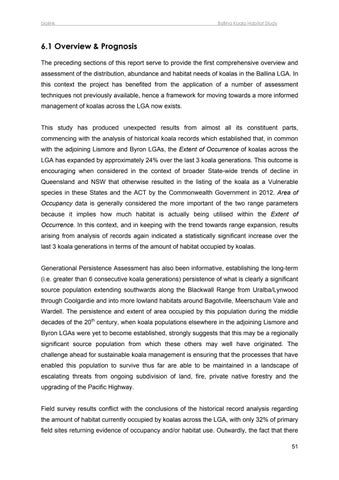biolink
Ballina Koala Habitat Study
6.1 Overview & Prognosis The preceding sections of this report serve to provide the first comprehensive overview and assessment of the distribution, abundance and habitat needs of koalas in the Ballina LGA. In this context the project has benefited from the application of a number of assessment techniques not previously available, hence a framework for moving towards a more informed management of koalas across the LGA now exists.
This study has produced unexpected results from almost all its constituent parts, commencing with the analysis of historical koala records which established that, in common with the adjoining Lismore and Byron LGAs, the Extent of Occurrence of koalas across the LGA has expanded by approximately 24% over the last 3 koala generations. This outcome is encouraging when considered in the context of broader State-wide trends of decline in Queensland and NSW that otherwise resulted in the listing of the koala as a Vulnerable species in these States and the ACT by the Commonwealth Government in 2012. Area of Occupancy data is generally considered the more important of the two range parameters because it implies how much habitat is actually being utilised within the Extent of Occurrence. In this context, and in keeping with the trend towards range expansion, results arising from analysis of records again indicated a statistically significant increase over the last 3 koala generations in terms of the amount of habitat occupied by koalas.
Generational Persistence Assessment has also been informative, establishing the long-term (i.e. greater than 6 consecutive koala generations) persistence of what is clearly a significant source population extending southwards along the Blackwall Range from Uralba/Lynwood through Coolgardie and into more lowland habitats around Bagotville, Meerschaum Vale and Wardell. The persistence and extent of area occupied by this population during the middle decades of the 20th century, when koala populations elsewhere in the adjoining Lismore and Byron LGAs were yet to become established, strongly suggests that this may be a regionally significant source population from which these others may well have originated. The challenge ahead for sustainable koala management is ensuring that the processes that have enabled this population to survive thus far are able to be maintained in a landscape of escalating threats from ongoing subdivision of land, fire, private native forestry and the upgrading of the Pacific Highway.
Field survey results conflict with the conclusions of the historical record analysis regarding the amount of habitat currently occupied by koalas across the LGA, with only 32% of primary field sites returning evidence of occupancy and/or habitat use. Outwardly, the fact that there 51



